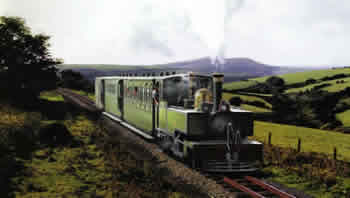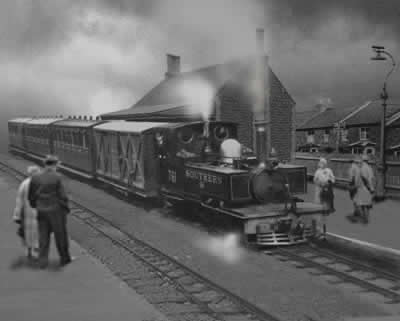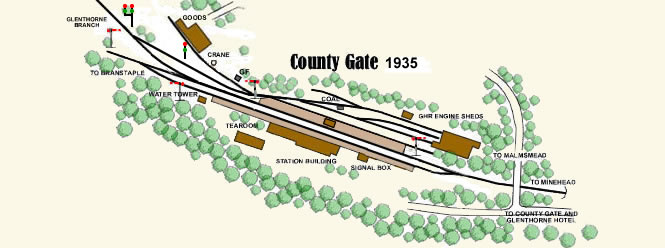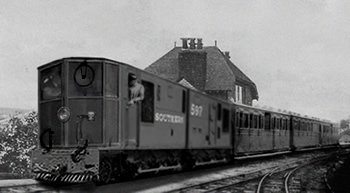|
grouping into the Southern Railway |


Southern Railway Days
The uncomfortable alliance between Halliday and
Newnes ended when the line was purchased by the present operators, Southern Railway, in 1922.
The Harbour and Porlock branches remained
privately owned by the Glenthorne Estate. The Glenthorne Harbour Authority
maintained running rights for trains between County Gate and Wootton
Courteney although, on many occasions, they do run further afield.
Many improvements have been made, including the building of
three new locomotives; 'Lew' and two
revolutionary Mallets designs
('River Avon' and 'River Brue') to work the heavier goods traffic and summer
tourist specials. At first glance it seems strange that a further Manning Wardle
was ordered as the North British locomotives have been far more successful.
I understand that North British were unable to supply another locomotive in
the time frame required. The Mallets are a new departure for the line, using
as they do, super heating, compounding and articulation, conceived after the successful use
of this type of locomotive on several narrow gauge lines in Europe. They are
the only Mallet locomotives working in Great Britain.

Baldwin 'Lyn' with a typical train
At first the prototype 'River Avon' suffered from a number of design flaws
and bad-luck; and was viewed with great suspicion by the loco crews It was also
involved in a serious accident a year after delivery.
Report of accident
here
'River Brue', delivered
some months after this unhappy accident, is a slightly expanded design with
the addition of leading and trailing pony trucks which considerably improve the ride qualities. As a result of this experience, 'River Avon' was returned
to Eastleigh and upgraded to near the same specification as 'River Brue',
taming the worst of her behaviour, but not saving her from an ill reputation
as ‘The Beast’, a situation unfortunately reinforced by her SR number, E666!
The Mallets just fit within the L&B loading gauge and by and large
perform well. Their low pressure cylinders have however required the removal
of some platform masonry along the line; indeed there have been a number of
locations where the locos have done it themselves! Likewise they are banned from
some sidings following several derailments due to spreading rails. These
issues aside, the introduction of these powerful locomotives have done much to
mitigate the extreme shortage of traction and an aging fleet.

Mallet 'River Avon' at
Barnstaple, circa 1931 (photo: Tate Stripnor)

Four new semi open coaches were also supplied
with a mind to the Minehead summer tourist trade. These were promptly
nicknamed 'Monsoons' by the railway staff as their deployment so often are a
harbinger of torrential rain! One magnificent Pullman coach was also provided
and this has become popular. If the railway had not begun to use railcars, I
suspect that several more Pullmans would have been built.
By this time however the line had begun to lose passenger and goods
traffic to improved road services. Coal traffic and general freight from the
harbour had now become the mainstay of the entire railway, though the line
remained very popular with tourists during the summer with summer specials
benefiting from the power of the Mallets.
In 1930, Southern finally closed the short branch between Barbrook and
Lynton, replacing it with a coach service which took passengers from Barbrook
to the centre of Lynton. This simplified the train service considerably as
now the line could be operated as a ‘through line’ from Minehead to
Barnstaple. In practice, as before, it is usual to change trains at Barbrook. Local protestations over the closure were met with a robust
response from Eastleigh who pointed out that as Lynton station was a
considerable distance from the centre of Lynton and had been the subject of
public complaint for many years, a further short distance by charabanc which
ran to the centre of Lynton, was a considerable improvement. Nevertheless,
plans have at last been laid to build a new station at Lynton.
Despite the cessation of services, the track and station remain. As nature
has begun to reclaim the right of way, Lynton station is used as a repository
for rolling stock awaiting attention. The engine and goods sheds and station
building are rented to local Lynton businesses.
In January 1933, a very heavy storm caused flooding at County Gate. The
spring and pond which supplied water for the locomotives overflowed and
washed out part of the platform. This has still not been fully repaired but
work is due to start shortly.
By 1930, profitability was in decline and rumours abounded that there were
plans to close the line. A reduction in the labour force was made which
quickly resulted in the railway wearing a slightly 'care-worn' look. By early
1931 the situation had further deteriorated and an attempt to close the line
was made. Southern Railway was thwarted by agreements that had been
previously made between
the Glenthorne Harbour Authority and the extended railway which would have
resulted in potentially expensive litigation unlikely to reach a satisfactory
conclusion.

A moody scene at Minehead as 'Taw' comes to a
standstill.
Southern, as a consequence, began to experiment with railcars in order to
reduce costs during low traffic periods. Eastleigh, who wanted to promote
their 'modern' image, have decided to use the railway as a 'guinea pig' to develop
a new generation of diesel electric railcars. A French engineer, Jehan du
Pontivice, who had gained considerable experience in railcar design while
working at the Bugatti factory in France was employed as consultant.
The prototype unit, no. 200 was delivered in January 1932 and entered service
that March to positive response, despite teething troubles. The railcar was
delivered without first class compartments, and as a consequence, was always
attached to a combo coach.
Accordingly a further unit, no. 201, much improved
and restyled, was delivered in Spring the following year from Short Brothers
of Rochester. For the first time in many years, the railway became the
fastest way to travel in the area and local traffic began to return. From
making a substantial loss during winter months, passenger returns actually
showed a small profit. Steam traction continued to be employed during the
tourist season when long trains were required and of course continued with
goods traffic. Nevertheless, it was quickly discovered that the railcars could
easily haul further coaches if it was necessary to strengthen the train.
In 1934, Eastleigh delivered the first production railcars designed for
main-line operations, which could potentially be expanded to five coaches.
Numbered 301, 302 and 303. One is painted in a dashing aqua green livery while the
others are presented in polished metal with a green waistline. Even the
interiors are avant-garde with fabric and floor coverings specially made for
each railcar set.
The four coach set numbered 304 was presented at
the 1934 Paris Salon prior to delivery to Barnstaple. Much to the delight of Eastleigh, it won the
coveted first
prize for transport innovation and design.

the prestigious white gold trophy from the Paris Salon
The new units
have quickly
become the pride of the operating staff and are very popular with passengers.
One can sense that those working on the line have a new spring to their
step! Railcar no 302 has recently been sold to the Glenthorne Harbour branch
to strengthen the passenger service which is increasing quickly and
now brings extra traffic to the railway.
The track layout at County Gate was changed
during the 1932 winter season as the harbour passenger traffic was rapidly
increasing. There is now a direct line from the harbour to the bay platform
at County Gate. This has much simplified operations.

The success of these railcars in bringing back passenger traffic has prompted
the Southern to again consider relocating the Lynton station buildings down the
hill to the site near the Glenlyn viaduct where Newnes had first demanded a
new station be built, providing a more convenient service for Lynton and
removing the cost of operating the charabanc service from Barbrook. While no
decision has been made by 1935, many locals feel that if the Southern choose
to carry this plan through, it would demonstrate a long-term commitment to
the line’s survival.


In May of this year, the two further railcars have
been
delivered from Eastleigh; nos. 304 and 305. At the time of writing, they have
just been fully commissioned and their modernity has delighted all who use
the line. The prototype railcars 200 and 201 have just been acquired by the GHA for their passenger services.
It appears that steam traction on this line will be a thing of the past
within a few short years.
A new railcar servicing facility has been
constructed at Glenlyn Yard, previously nicknamed 'Little Pilton', it is now
referred to as the 'Tram depot'.
'Yeo', 'Lew', 'Axe', 'Lyd', and 'River Brue' have been recently completely
overhauled, but 'Taw', 'Exe', 'Lyn' and 'River Avon' are near the end
of their service lives. It is
certain that steam locomotives will be withdrawn when major repairs are
required. They may be replaced by sisters of the new Armstrong Whitworth diesel
electric unit, currently on trials or by the experimental diesel electric
locomotives being developed at Eastleigh.
'River Avill' is an articulated locomotive; effectively two engines back to
back. Each employs a 330hp LV Sulzer engine, connected to the driving wheels by electric
transmission to one axle with the remaining wheels coupled
with rods. Initial results are very promising and I understand that footplate
crews are enthusiastic. The locomotive does has the disadvantage of having
two diesels so it is only economic to operate on long trains.
The coupling rods to the remaining driving wheels could also be a long term
source of maintenance costs.

One the 330 hp Sulzer engines supplied by Armstrong Whitworth installed in
'River Avill'
I suspect that the Eastleigh built locomotive,
'River Aller' will
actually outshine 'River Avill'. Time will tell. This has the more modern 400 hp
Sulzer LD engine with traction motors fitted to all four axles. As the
driving wheels are fitted in bogies, damage to track will be minimised. I
understand that Eastleigh are investigating the possibility of being able to
link two of these units together when required and operating both of them
from a single driving position.
The Eastleigh design is certainly very modern in
its appearance.

The railway comes of age.
Diesel electric 'River Avill' on trials at Dunster - photo L.T.Catchpole

the Eastleigh designed
locomotive. drawing - courtesy of Southern Railway
The East in ascendancy
There has always been some rivalry between those
operating Pilton Yard and those at Glenlyn Yard, often called 'Little
Pilton. Staff at Pilton have been slow to embrace the gradual conversion to
diesel traction. This has resulted in diesel maintenance and shedding at
Glenlyn.
click
here
and
here
to see recent film of the Lynton and Barnstaple Railway

A GWR map of 1933 showing the rail
network (Barnstaple/Minehead in green and Glenthorne branches in red)

|